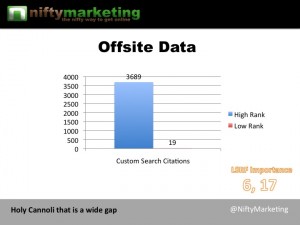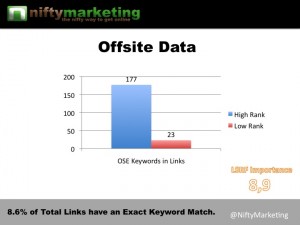Nifty Hard Core Local SEO Tactics From SMX Advanced
The panelists at last week’s “HardCore Local SEO” panel at SMX Advanced, Mike Ramsey of Nifty Marketing, Will Scott of Search Influence and David Mihm of GetListed, presented some excellent data on various tactical approaches to improving Google Place Page rankings. For today’s column, I thought it would be helpful to excerpt some of the […]
The panelists at last week’s “HardCore Local SEO” panel at SMX Advanced, Mike Ramsey of Nifty Marketing, Will Scott of Search Influence and David Mihm of GetListed, presented some excellent data on various tactical approaches to improving Google Place Page rankings. For today’s column, I thought it would be helpful to excerpt some of the more interesting ideas they presented.
I was particularly intrigued by Mike Ramsey’s presentation on research he had done where he compared 28 listings that ranked in the top 7 results for some local queries to 28 listings that did not rank as well. Mike started things off by warning the audience that “correlation does not equal causation“.
In other words, this data is interesting, but that doesn’t mean if you use it for SEO that you are going to rank #1.
First, Mike compared the high-ranking listings to the low-ranking listings for some of the factors mentioned in this year’s Local Search Ranking Factors Survey:
As you can see, both the high- and low-ranked listings had about the same number of claimed listings and exact categorizations on their Place Pages – two factors that were given high importance in this year’s survey. The most striking difference is that many more, but not all, high ranking listings had reviews on IYP sites.
While many of the listings had relatively few citations (references to the business on other supposedly relevant sites), searching for information about the business in Google Web Search told a different story:
High ranking listings appear to have significantly more “offsite data”. A similar gap appeared when checking Open Site Explorer for links to each business’ website:
Similar patterns showed up when checking for exact match keywords in anchor text to the listing websites:
and keywords in the anchor text:
Another great point was how making simple tweaks to the landing page URL like adding the address and phone number to the title tag can result in quick results:
Will Scott spoke about how you really have to work the system to to improve your Google Places rankings such as making sure you clean up listings that might be causing you problems, such as a Place Page for someone who used to work in the same location as yours.
One case study on a Place Page that had duplication and location problems showed how it took seven edits to the Place Page over three months before Google fixed the issues and started ranking the listing on page 1 for target queries. Local SEO does indeed take patience and endurance.
Will also showed off a variety of citation sources including Article Engines (be sure to include all of your location information on any articles you syndicate out about your business), Facebook and “Other” (a.k.a. SPAM).
In my experience, these relatively low value links do indeed seem to do the trick, but in the long run, you’ll want to supplement these kind of tactics with more solid citation sources, which of course are much harder to get.
David Mihm’s presentation had all sorts of good information with a focus on how to maintain a “geographic scent” for your website with the #1 recommendation being having a consistent name, address and phone number appear for your business across the Web.
Since much has been written in these pages about how to do this, I thought I’d focus on a couple of David’s points that were “extra credit”:
- Submit a KML sitemap in Google Webmaster Tools. This helps send Google the “I am really located here” signal. Here’s an easy tool to help you do it GeoSitemapGenerator.
- For multiple locations, claim all of your Google Place listings in a corporate Google account. If you are submitting a bulk feed, get it verified. Your Google Account must match the URLs of the Places you are submitting. Each location must have its own unique phone number or it won’t get approved.
- If you want to generate reviews, find customers with Google and Yahoo email addresses. Since you know they have accounts with these sites, you can send them links asking them to write a review for you on them and they’ll likely already be signed in.
All in all, it was an awesome session. I encourage you to check out the panelists’ sites as they all share a lot of great information:
Contributing authors are invited to create content for Search Engine Land and are chosen for their expertise and contribution to the search community. Our contributors work under the oversight of the editorial staff and contributions are checked for quality and relevance to our readers. The opinions they express are their own.
Related stories
New on Search Engine Land





